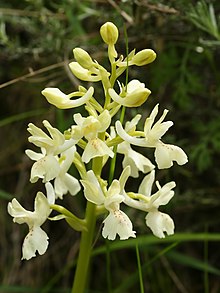Orchideae
| Orchideae | |
|---|---|

| |
| Flower of Orchis provincialis | |
| Scientific classification | |
| Kingdom: | Plantae |
| Clade: | Tracheophytes |
| Clade: | Angiosperms |
| Clade: | Monocots |
| Order: | Asparagales |
| Family: | Orchidaceae |
| Subfamily: | Orchidoideae |
| Tribe: | Orchideae (Dressler & Dodson) Verm. (1977) |
| Subtribes | |
| |
Orchideae is a tribe of orchids in the subfamily Orchidoideae. It is the largest tribe, containing more than 1,700 species.[citation needed] It has been divided into two subtribes, Orchidinae and Habenariinae. However, although phylogenetic studies have established the monophyly of the subtribes, the generic boundaries are unclear, with many genera as traditionally circumscribed being paraphyletic or even polyphyletic.[1] Species of genera such as Habenaria and Platanthera are placed into both subtribes,[2] so a clear assignment of all genera to subtribes is not possible as of March 2018[update].
The Asian species of Orchideae, in particular, have been subject to repeated changes of generic placement from 2012 onwards.[2][1][3][4][5]

Genera include:[citation needed]
- Anacamptis, Bartholina, Benthamia, Bonatea, Brachycorythis, Centrostigma, Chamorchis, Cynorkis, Dactylorhiza, Diplomeris, Dracomonticola, Galearis, Gennaria, Gymnadenia, Habenaria, Hemipilia, Herminium, Himantoglossum, Holothrix, Megalorchis, Neobolusia, Neotinea, Oligophyton, Ophrys, Orchis, Pecteilis, Peristylus, Physoceras, Platanthera, Platycoryne, Ponerorchis, Pseudorchis, Roeperocharis, Schizochilus, Serapias, Sirindhornia, Stenoglottis, Steveniella, Thulinia, Traunsteinera, Tsaiorchis, Tylostigma, Veyretella
Genera included in a 2014 molecular phylogenetic study are listed below, together with subfamily clades into which their species were placed. Four genera were split between the two subfamilies.[1]
- Bonatea – Habenariinae
- Dactylorhiza – Orchidinae
- Galearis (including Neolindleya) – Orchidinae
- Gennaria – Habenariinae
- Gymnadenia – Orchidinae
- Habenaria – Habenariinae
- Hemipilia (including Hemipiliopsis) – Orchidinae
- Herminium (including Androcorys, Porolabium) – Habenariinae, Orchidinae
- Ophrys – Orchidinae
- Orchis – Orchidinae
- Pecteilis – Habenariinae
- Peristylus – Habenariinae, Orchidinae
- Platanthera (including Smithorchis) – Habenariinae, Orchidinae
- Ponerorchis (including Amitostigma, Neottianthe) – Habenariinae, Orchidinae
- Pseudorchis – Orchidinae
- Serapias – Orchidinae
- Sirindhornia – Orchidinae
- Tsaiorchis – Orchidinae
See also
References
- ^ a b c Jin, Wei-Tao; Jin, Xiao-Hua; Schuiteman, André; Li, De-Zhu; Xiang, Xiao-Guo; Huang, Wei-Chang; Li, Jian-Wu; Huang, Lu-Qi (2014), "Molecular systematics of subtribe Orchidinae and Asian taxa of Habenariinae (Orchideae, Orchidaceae) based on plastid matK, rbcL and nuclear ITS", Molecular Phylogenetics and Evolution, 77: 41–53, doi:10.1016/j.ympev.2014.04.004
{{citation}}: Unknown parameter|lastauthoramp=ignored (|name-list-style=suggested) (help) - ^ a b Jin, Xiao-Hua; Li, De-Zhu; Xiang, Xiao-Guo; Lai, Yang-Jun; Shi, Xiao-Chun (2012), "Nujiangia (Orchidaceae: Orchideae): A new genus from the Himalayas", Journal of Systematics and Evolution, 50 (1): 64–71, doi:10.1111/j.1759-6831.2011.00167.x
{{citation}}: Unknown parameter|lastauthoramp=ignored (|name-list-style=suggested) (help) - ^ Tang, Ying; Yukawa, Tomohisa; Bateman, Richard M.; Jiang, Hong; Peng, Hua (2015), "Phylogeny and classification of the East Asian Amitostigma alliance (Orchidaceae: Orchideae) based on six DNA markers", BMC Evolutionary Biology, 15: 96, doi:10.1186/s12862-015-0376-3
{{citation}}: Unknown parameter|lastauthoramp=ignored (|name-list-style=suggested) (help)CS1 maint: unflagged free DOI (link) - ^ Jin, Weitao; Xiang, Xiaoguo; Jin, Xiaohua (2015), "Generic delimitation of Orchidaceae from China: current situation and perspective" (pdf), Biodiversity Science (in Chinese and English), 23 (2): 237–242, doi:10.17520/biods.2014268, retrieved 2018-04-01
{{citation}}: Unknown parameter|lastauthoramp=ignored (|name-list-style=suggested) (help) - ^ Raskoti, Bhakta Bahadur; Jin, Wei-Tao; Xiang, Xiao-Guo; Schuiteman, André; Li, De-Zhu; Li, Jian-Wu; Huang, Wei-Chang; Jin, Xiao-Hua; Huang, Lu-Qi (2016) [2015 online], "A phylogenetic analysis of molecular and morphological characters of Herminium (Orchidaceae, Orchideae): evolutionary relationships, taxonomy, and patterns of character evolution", Cladistics, 32 (2): 198–210, doi:10.1111/cla.12125
{{citation}}: Unknown parameter|lastauthoramp=ignored (|name-list-style=suggested) (help)
External links
